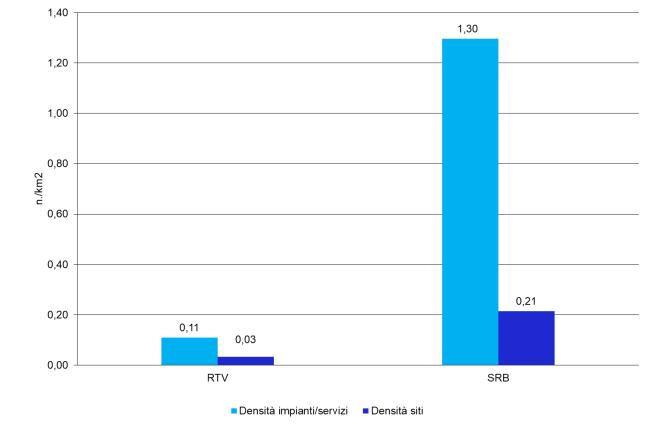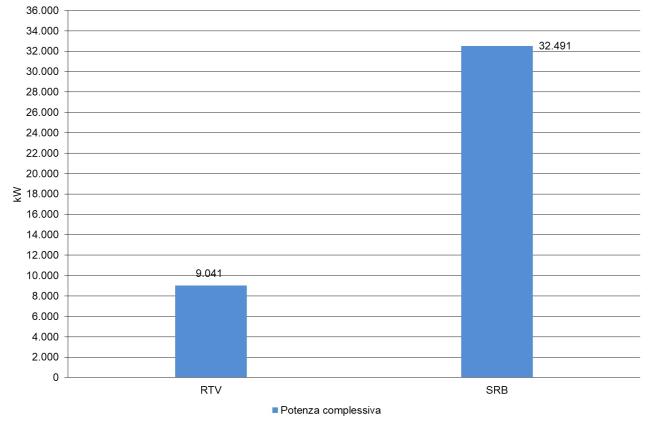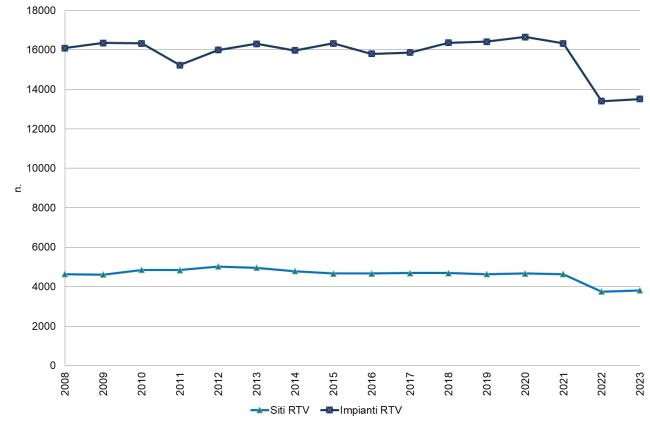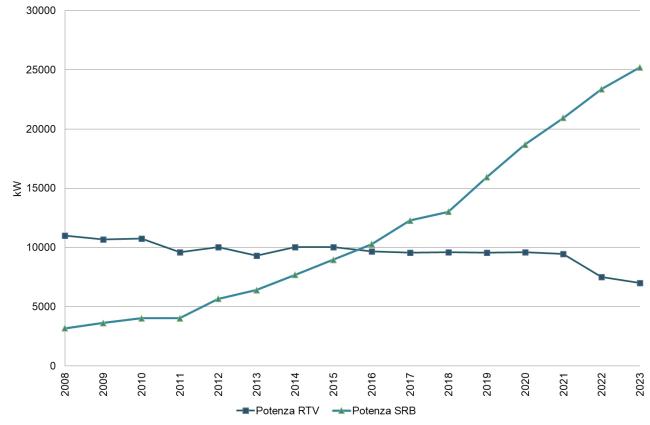Panel 1
Gabriele Bellabarba, Maria Logorelli
The indicator reports, for each region/autonomous province, the absolute number, the normalized number (per inhabitants and surface area), and the power of radio and television broadcasting (RTV) facilities and base transceiver station (BTS) services for mobile communication. It also specifies the number of sites where the facilities/services are installed.
In 2023, the number of sites and RTV facilities showed slight variations compared to the previous year (+1.8% RTV sites, +0.8% RTV facilities), increasing from 3,750 to 3,819 RTV sites and from 13,398 to 13,508 RTV facilities. The total RTV power decreased by 6.6%, dropping from 7,519 kW to 7,022 kW.
Regarding Base Transceiver Stations (BTS) for mobile communication, 2023 saw a slight increase compared to 2022 in the number of sites (+0.3%), facilities (+0.5%), and services (+1.6%), rising from 28,274 to 28,370 BTS sites, from 42,997 to 43,209 BTS facilities, and from 147,598 to 150,029 SRB services. The total BTS power recorded a significant increase (+7.8%), growing from 23,367 kW to 25,199 kW.
The indicator provides, for each region/autonomous province, the absolute number, the normalized number (relative to the population and surface area), and the power levels of radio and television (RTV) installations and base transceiver station (BTS) services for mobile communication . It also specifies the number of sites where the installations/services are located.
An RTV installation refers to an element associated with a specific transmission frequency, while a BTS service refers to the type of implemented transmission system (e.g., GSM, UMTS 900, UMTS 1800, etc.). A site refers to the location or address where the installation/service is placed.
Quantifying the main sources of pressure on the territory for radiofrequency fields.
Framework Law 36/2001 and its implementing decree DPCM 8/07/2003 (RF) and subsequent amendments; Legislative Decree 259/2003 and subsequent amendments.
Article 4 of Framework Law 36/2001 on protection from exposure to electric, magnetic, and electromagnetic fields provides for the establishment of a national register of fixed and mobile sources of electric, magnetic, and electromagnetic fields, as well as the territorial areas affected. It also mandates the creation of regional registers, developed in coordination with the national register.
On February 13, 2014, the ministerial decree establishing the register was issued, following a consultation process between the Institute for Environmental Protection and Research (ISPRA) and regional environmental protection agencies (ARPA)/ provincial environmental protection agencises (APPA) that had begun several years earlier to define and share the technical specifications for its implementation.
The National Electromagnetic Fileds Register operates in coordination with the various Regional Electromagnetic Fileds Registers. Regional projects funded by Ministry of environment and energy security have been launched in accordance with the provisions of DD No. 72/2016 concerning the implementation and management of Regional Electromagnetic Fileds Registers. This initiative is expected to provide a significant positive boost to their full operationalization and, consequently, to the effectiveness of the National Electromagnetic Fileds Register.
Panel 2
The Italian Institute for Environmental Protection and Research, different years, Environmental Data Yearbooks
The Italian Institute for Environmental Protection and Research, Thematic Reports
There are numerous challenges in obtaining information on the installations in question, including issues related to spatial and temporal coverage and data quality, particularly for radio and television (RTV) installations. These installations have largely been present across the national territory for a long time, having spread uncontrollably during the 1970s and 1980s due to the lack of specific national regulations at the time.
Additional factors contributing to these challenges include delays in implementing specific regulatory requirements for data provision by the operators, inefficiencies in local data collection tools, and a lack of dedicated human and financial resources for this data collection activity.
Synergistic actions by the stakeholders involved in supporting the flow of information through appropriate regulatory tools and targeted activities aimed at analyzing the aforementioned challenges, with the goal of clarifying issues and proposing solutions to ensure greater uniformity and completeness of data at the national level.
Data quality assessment
Electromagnetic Fileds Observatory
11/20
2008-2023
Indicator assessment
Ratio of the number of installations/services to the segional surface area and resident population. Calculation of site and installation/service density by relating the total number of sites/(installations/services) to the total territorial surface area. Sum of the total regional power at the antenna connector.
Considering the data provided by the ARPA/APPA representatives for 2023, it is observed that Base Transceiver Stations (BTS) have a service density across the entire national territory that is 11.9 times higher than that of radio and television (RTV) installations (1.30 vs. 0.11 per km², respectively). The density of BTS sites (0.21 sites per km²) is seven times higher than that of RTV sites (0.03 sites per km²) (Figure 1). The total power of BTS installations (32,491 kW) is significantly higher than that of RTV installations (9,041 kW) (Figure 2).
The above calculations consider only the regions/autonomous provinces that provided updated and complete data for 2023 for both types of sources (RTV and BTS): Piedmont, Aosta Valley, Lombardia, Trentino-Alto Adige, Veneto, Friuli-Venezia Giulia, Emilia-Romagna, Tuscany, Umbria, Campania, and Sicily.
It should be noted that variations affecting both RTV and BTS installations are only partially attributable to actual changes in territorial installations. In fact, in some cases, regional representatives report that these variations are due to more accurate information obtained through the use of new regional databases for data collection, as well as monitoring and verification activities carried out by the operators themselves.
For the trend analysis, the regions/autonomous provinces that provided complete data for the 2008–2023 period for both types of sources (RTV and BTS) were considered, along with those for which missing information could be integrated by using relevant data from the previous year or, if unavailable, from the first subsequent available year (Piedmont, Aosta Valley, Lombardy, Autonomous Province of Bolzano, Veneto, Emilia-Romagna, Tuscany, Umbria, and Marche).
Figures 3, 4, and 5 illustrate the different trends characterizing these two types of radio telecommunication installations over the 2008–2023 period. The number of RTV sites and installations remained almost unchanged until 2021; however, in 2022, there was a significant decrease (-19.2% in RTV sites, -17.9% in RTV installations). In 2023, slight variations were recorded (+1.8% in RTV sites, +0.8% in RTV installations), increasing from 3,750 to 3,819 RTV sites and from 13,398 to 13,508 RTV installations. The total RTV power followed a downward trend until 2022, with a further decrease recorded in 2023 (-6.6%), dropping from 7,519 kW to 7,022 kW.
These variations are only partially attributable to actual changes in installations across the territory. In some cases, regional representatives report that these fluctuations are due to more accurate data collection enabled by new regional databases and monitoring and verification activities carried out by the operators themselves.
Regarding Base Transceiver Stations (BTS) for mobile communication, the trend from 2008 to 2023 has generally been upward in terms of installations, sites, services, and power, except for 2022, when the number of services experienced a slight decline (-6.6%), decreasing from 158,022 to 147,598, likely due to mobile network reconfiguration. In 2023, a slight increase was observed in sites (from 28,274 to 28,370, +0.3%), installations (from 42,997 to 43,209, +0.5%), and services (from 147,598 to 150,029, +1.6%). The total BTS power saw a significant increase in 2023 (+7.8%), rising from 23,367 kW to 25,199 kW.
As with RTV installations, the data analyzed may reflect improved reporting on existing installations rather than actual changes in the number of installations.
Data
Table 1: Number of Radio and Television (RTV) Installations, Number of Sites, and Total Power Associated (2023)
ISPRA elaboration based on ARPA/APPA data (EMF Observatory), ISTAT data (as of 01/01/2024)
a The total for Italy refers to the regions for which the data is updated and complete;
b Data not updated;
c Region/Autonomous Province that provided the updated and complete data for both types of electromagnetic sources (RTV and BTS) for the year 2023;
* The data does not cover the entire regional territory;
nd: data not available.
For Emilia Romagna, regarding the source, it is highlighted that a general verification of radio installations is underway across the regional territory, with data updates based on information from the ROC, previous documentation, and scheduled on-site inspections. In Forlì, the recovery of lost documentation due to the flood is in progress.
Table 2: Number of Services for Base Station Radio (BTS), Number of Sites, and Total Power Associated (2023)
ISPRA elaboration based on ARPA/APPA data (EMF Observatory), ISTAT data (as of 01/01/2024)
a The total for Italy refers to the regions for which the data is updated and complete;
b Data not updated;
c Region/Autonomous Province that provided the updated and complete data for both types of electromagnetic sources (RTV and BTS) for the year 2023;
nd: data not available.
Figure 1: Density of installations/services and sites, comparison between RTV and BTS, for regions with complete data available for both source types (2023).**
ISPRA elaboration based on ARPA/APPA data (EMF Observatory)
The regions/autonomous provinces that provided complete data for both source types (RTV and BTS) for the year 2023 have been considered (Piedmont, Aosta Valley, Lombardy, Trentino-Alto Adige, Veneto, Friuli Venezia Giulia, Emilia Romagna, Tuscany, Umbria, Campania, and Sicily).
Figure 2: Total power, comparison between RTV and BTS, for regions with complete data available for both source types (2023)
ISPRA elaborations based on ARPA/APPA data (EMF Observatory)
Regions/autonomous provinces that provided complete data for both types of sources (RTV and BTS) for the year 2023 were considered (Piedmont, Aosta Valley, Lombardy, Trentino-Alto Adige, Veneto, Friuli Venezia Giulia, Emilia-Romagna, Tuscany, Umbria, Campania, and Sicily).
ISPRA elaboration based on ARPA/APPA data (EMF Observatory)
Both the regions/autonomous provinces that provided complete data for the time period 2008-2023 for both RTV and BTS source types, as well as those that provided partial information which was subsequently completed using a statistical method, have been considered (Piedmont, Aosta Valley, Lombardy, Autonomous Province of Bolzano, Veneto, Emilia Romagna, Tuscany, Umbria, and Marche).
Figure 4: Number of BTS installations, services, and sites over the time period 2008-2023
ISPRA elaboration based on ARPA/APPA data (EMF Observatory)
Both the regions/autonomous provinces that provided complete data for the time period 2008-2023 for both RTV and BTS source types, as well as those that provided partial information which was subsequently completed using a statistical method, have been considered (Piedmont, Aosta Valley, Lombardy, Autonomous Province of Bolzano, Veneto, Emilia Romagna, Tuscany, Umbria, and Marche).
ISPRA elaboration based on ARPA/APPA data (EMF Observatory)
Both the regions/autonomous provinces that provided complete data for the time period 2008-2023 for both RTV and BTS source types, as well as those that provided partial information which was subsequently completed using a statistical method, have been considered (Piedmont, Aosta Valley, Lombardy, Autonomous Province of Bolzano, Veneto, Emilia Romagna, Tuscany, Umbria, and Marche).





There continues to be a significant gap between the total power levels characterizing the two types of electromagnetic sources (RTV and BTS). The technological advancements in the mobile telephony sector and, consequently, the increasing presence of new BTS services across the territory have inevitably led to a higher total power for BTS installations compared to RTV installations.
It is important to note that the comparison is made between RTV installations and BTS services, as both are, by definition, associated with the implemented transmission system. The continuous growth in the number of BTS services and their total power reflects the rapid technological development that continues to shape the mobile telephony sector, with the evolution of communication technologies from 2G up to 5G.
There remain numerous challenges in gathering information on the installations in question. Some of these difficulties stem from delays in implementing specific regulatory requirements for data provision by the operators, inefficiencies in local data collection tools, and a lack of dedicated human and financial resources for this data collection activity. As a result, some regions do not have available or updated data.
However, it is essential to emphasize that the development of data collection tools such as databases and registries contributes to a more comprehensive understanding of RF installations across the territory. Consequently, variations in the data related to these installations may be linked either to actual changes in the number of sites, installations, and RTV/BTS services or to improved data accuracy made available to ARPA/APPA representatives through their data collection systems (such as registries and digital archives).